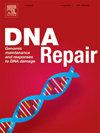Targeting base excision repair in precision oncology
IF 2.7
3区 生物学
Q2 GENETICS & HEREDITY
引用次数: 0
Abstract
Targeting the DNA damage response (DDR) is a key strategy in cancer therapy, leveraging tumour-specific weaknesses in DNA repair pathways to enhance treatment efficacy. Traditional treatments, such as chemotherapy and radiation, use a broad, damage-inducing approach, whereas precision oncology aims to tailor therapies to specific genetic mutations or vulnerabilities. The clinical success of PARP inhibitors has renewed the interest in targeting DNA repair as a therapeutic strategy. Expanding the precision oncology toolbox by targeting the base excision repair (BER) pathway presents a promising avenue for cancer therapy, particularly in tumours that rely heavily on this pathway due to deficiencies in other DNA repair mechanisms. This review discusses how targeting BER could improve treatment outcomes, particularly in DDR-defective cancers. With ongoing advancements in biomarker discovery and drug development, BER-targeted therapies hold significant potential for refining precision oncology approaches.
精准肿瘤学中靶向碱基切除修复
靶向DNA损伤反应(DDR)是癌症治疗的关键策略,利用肿瘤特异性DNA修复途径的弱点来提高治疗效果。传统的治疗方法,如化疗和放疗,使用广泛的、诱导损伤的方法,而精确肿瘤学的目标是针对特定的基因突变或脆弱性定制治疗方法。PARP抑制剂的临床成功重新燃起了靶向DNA修复作为治疗策略的兴趣。通过靶向碱基切除修复(BER)途径来扩展精确肿瘤学工具箱,为癌症治疗提供了一条有希望的途径,特别是在由于其他DNA修复机制缺乏而严重依赖该途径的肿瘤中。这篇综述讨论了靶向BER如何改善治疗结果,特别是在耐多药缺陷癌症中。随着生物标志物发现和药物开发的不断进步,ber靶向治疗在改进精确肿瘤学方法方面具有巨大的潜力。
本文章由计算机程序翻译,如有差异,请以英文原文为准。
求助全文
约1分钟内获得全文
求助全文
来源期刊

DNA Repair
生物-毒理学
CiteScore
7.60
自引率
5.30%
发文量
91
审稿时长
59 days
期刊介绍:
DNA Repair provides a forum for the comprehensive coverage of DNA repair and cellular responses to DNA damage. The journal publishes original observations on genetic, cellular, biochemical, structural and molecular aspects of DNA repair, mutagenesis, cell cycle regulation, apoptosis and other biological responses in cells exposed to genomic insult, as well as their relationship to human disease.
DNA Repair publishes full-length research articles, brief reports on research, and reviews. The journal welcomes articles describing databases, methods and new technologies supporting research on DNA repair and responses to DNA damage. Letters to the Editor, hot topics and classics in DNA repair, historical reflections, book reviews and meeting reports also will be considered for publication.
 求助内容:
求助内容: 应助结果提醒方式:
应助结果提醒方式:


